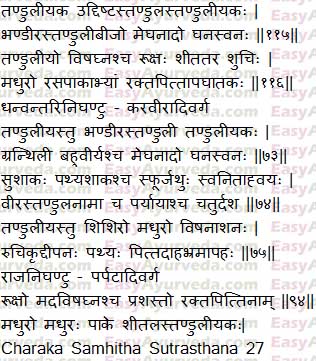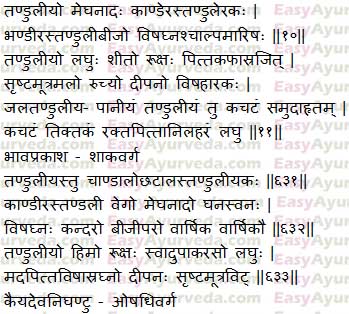Thorny Amaranth – Tanduliyaka Uses, Qualities, Remedies, Research
By Dr Renita D’Souza
Thorny amaranth (Amaranthus spinosus) is a highly nutritious underutilized vegetable well known for its medicinal benefits. It is used in the treatment of excess menstrual bleeding, blood related diseases, general debility, piles, blisters, burning sensation, snake bite etc. The medicinal usage and qualities of the plant varies in different regions all over the world. The plant is rich source of calcium, iron, Vitamin B and C.
It is considered as wholesome diet in excess menstrual bleeding, blisters, mutraghata (dysuria), asthma, poisoning, alcohol intoxication, post surgery, vaginal white discharge etc
Read – Malabar Spinach – Uses, Remedies, Benefits, Research
Botanical Name – Amaranthus spinosus
Family – Amaranthaceae
Table of Contents
Vernacular Names
English Name – Prickly amaranth, Edlebur, Needle burr, Spiny amaranth, Thorny amaranth, Spiny pigweed
Sanskrit Name – Tanduliyaka
Hindi Name – Chaulai, Chaurayi, Kataili chaulai, Kanta chaulai
Bengali Name – Kanta nate, Kantanotya
Marathi Name – Kante math, Kante bhaji
Gujarati Name – Kantalo Damo
Kannada Name – Mulluharive soppu
Telugu Name – Mola tota kura, Mullatotakura
Tamil Name – Mullukkeerai
Malayalam – Kattumullenkeera, Cherucheera
Manipuri Name – Chengkruk
Nepali Name – Kaande lunde, Bandanee, Ban lunde
Read – Apamarga – Achyranthes aspera – Uses, Dose, Side Effects
Morphology, Distribution
Morphology
Amaranthus spinosus is an annual erect herb, growing up to 100 – 130 cm long. Stem is usually branched, cylindrical, smooth, glabrous or slightly pubescent, green or red tinged. Leaves are alternate, simple, ovate to rhombic-ovate, elliptic, lanceolate-oblong, or lanceolate. Flowers are green in color. Fruit oblong dehiscent capsule with one seed. Seed 1 mm diameter, shiny black color.
Distribution
Amaranthus spinosus is found native to tropical America.
Medicinal Qualities
Taste – sweet
Vipaka (taste conversion after digestion) – sweet
Laghu – light to digest
Virya (potency) – cold
Ruksha – dry
Ruchya – improves taste
Deepana – kindles digestive fire
Effect on Tridoshas
Balances pitta and kapha dosha
Read – Pointed Gourd Health Benefits, Usage – Ayurveda Details
Traditional Uses
Sreshta mutra mala – causes expulsion of urine and feces
Asrajith – cures blood diseases
Vishaharaka -relieves intoxication
Raktapitta – bleeding diseases
Daha – burning sensation
Bramah – Giddiness
Traditional Remedies
- In Pittaja menorrhagia, root of tanduliyaka is given with honey.
- In heavy menstrual periods, roots of tanduliyaka is given along with Gooseberry, bark of Ashoka and Daaruharidra. This combination helps to stop the bleeding.
- Whole plant is cooked with Pigeon pea (Harhar daal) and consumed to increase breast milk production.
- Root paste is applied over boils or tumors to cause suppuration. It also helps to cure contagious skin diseases.
- Leaf paste is applied externally to relieve burning sensation caused by herpes or any other skin disease.
- The boiled leaves and roots are used as laxative, diuretic, anti-diabetic, antipyretic, anti-snake venom, antileprotic, anti-gonorrheal, and expectorant. Relieves breathing in acute bronchitis.(A)
- Root is used in children to treat constipation due to its laxative action. It is also a good diuretic agent. Its decoction is applied externally to stimulate and increase menstrual flow. Also used to bring down the fever.
- The paste of leaves and roots are applied as poultice to treat abscesses, bruises, burn, eczema, inflammation, gonorrhea, menorrhagia and wound.
- To treat Jaundice, rheumatic pain and stomach ache, the leaves are boiled and given for 2 to 3 days.
- The fruit ash is used to treat jaundice.
- To control vomiting, root paste with equal quantity of honey is taken internally.
- In case of dysentery, root paste is mixed with sugar and taken along with water.
- In Rabies, 3 parts of root paste is mixed with 1 part of black pepper and given daily two times a day.
- Seeds are used internally in internal bleeding, diarrhea and excessive menstruation. In fractures, it is applied externally as poultice.
- Chandanadi Lepam – Paste of Red sandalwood, Nagakesara (Mesua ferrea), Shireesha (Albizzia lebbeck) and Jasmine leaves is prepared with juice of spiny amaranth. This paste is applied to relieve burning sensation associated with blisters.
- Tanduliyaka cooked with the milk processed with licorice and Madhuca longifolia is used in coughing up blood (hemoptysis).
- In rakta yoni (menorrhagia), root paste of tanduliyaka is mixed with honey and taken along with rice water (tandulambu).
Remedies for poisoning
- Griha-Dhuma (Kitchen-soot), Turmeric, Daruharidra and Tanduliyaka along with its root is mixed liberal quantity of honey and ghee. Intake of this cures a patient bitten by Vasuki (a celestial snake).
– Tanduliyaka triturated with the juice of Kakanda (Kakatinduka) is useful in all types of poison. - The plant is also used to induce abortion by certain tribes in Nepal and India.
- The root decoction is used to treat gonorrhea.
- Acute bronchitis – In Malaysia, the plant is used to treat acute bronchitis. It helps easy breathing and act as expectorant.
- Certain tribes use plant ash as salt.
- Indigestion – indigestion and constipation caused by excess intake of mango fruits is cured by taking hot water, tanduleeyaka root juice and sonchal salt. This helps to improve digestive fire and relieves constipation.
- Indigestion by Tanduleeyaka is cured by intake of mustard.
Sanskrit Verses


Read – Ridge Gourd: Benefits, Remedies, Research, Side Effects
Interaction with medicines, supplements
Can this be used while taking Homeopathic medicine?
Yes. This product does not react with homeopathic medicine.
Can
this medicine be continued while taking supplements like multivitamin tablets,
Omega 3 fatty acids etc?
Yes. Generally, this product goes well with most
of the dietary supplements. However, if you are taking more than one product
per day, please consult your doctor for an opinion.
With western
medicines
Seek your
doctor’s advice if you are taking this product along with other western
(allopathic / modern) medicines. Some Ayurvedic herbs can interact with modern
medicine.
If both Ayurvedic and allopathic medicines are advised together, then it is
best to take Allopathic medicine first, wait for 30 minutes and then take the
Ayurvedic medicine.
Nutritional Values
Amaranthus spinosus carbohydrates, proteins, fats, fibers, minerals such as iron, calcium, manganese, copper and zinc.
Phytochemical Constituents
Amaranthus spinosus contains alkaloids, flavonoids, glycosides, phenolic acids, steroids, amino acids, terpenoids, lipids, saponins, betalains, ß-sitosterol, stigmasterol, linoleic acid, rutin, catechuic tannins and carotenoids.
Pharmacological Activities
Amaranthus spinosus possess diuretic, Anti diabetic, Anti-hyperlipidaemic anti-fertility, anti inflammatory, anti ulcer, anti microbial, Anthelmintic activity, anti depressant, Immuno modulatory activity, Antigenic and Allergenic activity.
Research, Controversy
Research
Anti diabetic activity – Research study done to evaluate antidiabetic activity of Amaranthus spinosus leaf extract against streptozotocin-nicotinamide induced diabetes and oxidative stress in albino rat have proved that Amaranthus spinosus possess significant anti diabetic properties. It decreased the oxidative stress and pancreatic cells damage.
Antidepressent Activity – The study conducted to investigate anti depressant activity of Amaranthus spinous have proved that methanolic extract of Amaranthus spinosus possess significant anti depressant activity.
Controversy
Bhandira (Clerodendrum infortunatum) is a separate herb mentioned in Ayurvedic text book Dravya Guna Vijnana. Tanduliyaka herb also possess the synonym Bhandira.
Read – Bhandira Clerodendrum infortunatum: Uses, Research, Remedies
Ayurvedic Medicines, Sanskrit Synonyms
Ayurvedic Medicines
Ashoka Ghrita – Used in the treatment of menorrhagia, menstrual pain and bleeding, vaginal discharges etc
Chandanadi Thailam – It is used to relieve burning sensation, dizziness, etc. Used both for oral intake and external application.
Sanskrit Synonyms
Tanduliy, Meghanad, Kandera
Tanduleraka, Bhandira
Tandulibeeja
Vishagna – relieves intoxication
Alpamaarisha
Paaneeya tanduleeya
It is the variety of Tanduleeya, mentioned in Bhavaprakasha Nighantu.
Sanskrit Synonyms
Jalatanduliya, Kanchata
Medicinal Qualities
Taste – bitter
Laghu – light to digest
Anilahar – balances vata dosha
Raktapittahara – treats bleeding disorders
Categorization
Classical Categorization
Bhavaprakasha Nighantu – Shaka varga
Kaiyadeva Nighantu – Aushadhi varga
Dhanvantari Nighantu – Karaveeradi varga
Raja Nighantu – Parpatadi varga
Scientific Classification
Kingdom – Plantae
Subkingdom – Tracheobionta
Division – Magnoliophyta
Class – Magnoliopsida
Subclass – Caryophyllidae
Order – Caryophyllales
Genus – Amaranthus
Click to Consult Dr Renita D’Souza










